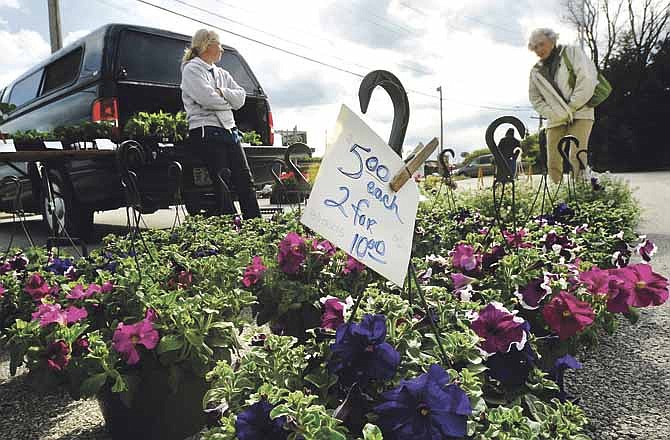A bushel or a peck, a potted plant, a cut of beef or pork, and even a jar of homemade jam or honey. Local farmers' markets are opening up for the season, and serving up fresh products to soothe the summer soul. In Jefferson City alone, three markets offer up locally grown produce and other goods.
A trend across the nation shows that connecting directly with the grower is becoming more and more popular, with new markets sprouting up yearly. Since 1994, the number of farmers' markets has more than quadrupled, with the USDA reporting 7,864 markets at the close of season in 2012. From 2011 to 2012, the USDA saw a 9.6 percent increase in the number farmers' markets.
"Meeting the people that grow your food fosters a special relationship and community that can't be duplicated at a supermarket," Damon Motley, organizer for the Capital Region Medical Center market said.
Local farmers set up in several locations throughout the city, various days of the week. Residents can visit the Cole County Farmers' Market along Missouri Boulevard in the Kmart parking lot, the Lincoln University Farmers' Market at the Dickinson Research Center on the corner of Chestnut and Leslie, and the Capital Region Medical Center Farmers' Market in the parking lot across from the Sam B. Cook Healthplex entrance.
With more than 200 farmers' markets in Missouri, each market offers a variety of goods, all made or grown by the local vendors.
Looking at the market from a customers' standpoint, choosing a product "puts the power of purchase back into the hands of the consumer," Lincoln University market coordinator Margaret Hopper said. "It allows the consumer the ability to choose how their food is grown and raised."
Because the products are being sold directly from the farmer, customers are free - and even encouraged - to ask questions. "The consumer gets to meet the person growing their food, which fosters new relationships within the community," Hopper explained.
Missouri Farmers Market Association president Lane McConnel, also market manager for the Farmers Market of the Ozarks of Springfield, encourages consumers to talk with the producer about their production practices. "How are they growing their productions? What type of seeds are they using? How are they getting the product from field to market?"
Market buying allows consumers the opportunity to buy items that fit their needs, and ideals. Hopper noted that along with knowing the farmer is local, and knowing his or her name, customers can learn if their cattle was raised anti-biotic free, or if produce was grown without chemicals and pesticides.
One major advantage to shopping a farmers' market is, of course, freshness.
"Things taste better when they are fresh. Produce is a lot fresher when it comes from 15 miles away rather than 1,500 miles away," Hopper noted.
When it comes to cost, the products at Farmers' markets are usually comparable to that of grocery stores. "However, the food will be fresher," Hopper said.
Buying locally at a market also contributes to supporting the local economy.
"Money tends to stay in the community," Hopper said.
For example, if Hopper purchases hamburger from Steve Smart and Invermos Valley Farm, a local vendor at the Lincoln Market, "every single cent of it stays right here in the area," she said.
Smart raises cattle on his land located in Callaway County, land that has been in his family for generations. The cow was born there, raised there, and butchered nearby at Swiss Meats near Hermann. "Every aspect of production, from birth to my table occurred within a 50-mile radius," Hopper related. "As a big foodie, I can say it tastes so much better."
This local production includes the farmer himself, the feed store, the veterinarian, the processor, and consumer.
The markets provide another avenue for farmers to sell their product. Markets encourage local, small farmers by allowing a starting point to enter into entrepreneurship. And consumers can rest assured, the products comply with state and local regulations. Consumers can have confidence in their food, because they've personally met the producer. Many markets also require food safety classes and inspections.
"I think there are often a lot more restrictions on vendors that sell at markets than a lot of other avenues," McConnel noted. "It (production) is also on a smaller scale, so there is less room for error."
The Cole County and Lincoln University markets opened last weekend for the season. The Cole County Farmers' Market has been a local tradition since 1992, with all vendors from Cole County or an adjoining county. It is open Tuesdays and Fridays from 4-6 p.m., and Saturdays from 2-4 p.m. The Lincoln Market is starting its second season and is open from 9 a.m. to noon on Saturdays and Thursdays 5 p.m. to 6:30 p.m. starting in June.
The Capital Region Medical Center Farmers' Market is starting its third season, and is open from 4-6 p.m. on Thursdays starting in mid-May.
How much is it?
Bushel = 32 dry quarts, 64 dry pints, or 2,150 cubic inches.
1 Peck = 1/4 bushel, 8 dry quarts or 538 cubic inches.
Gallon = 4 quarts or 231 cubic inches (liquid measure).
Kilogram (kg) = 2.205 pounds.
Liter = 1.057 liquid quarts.

